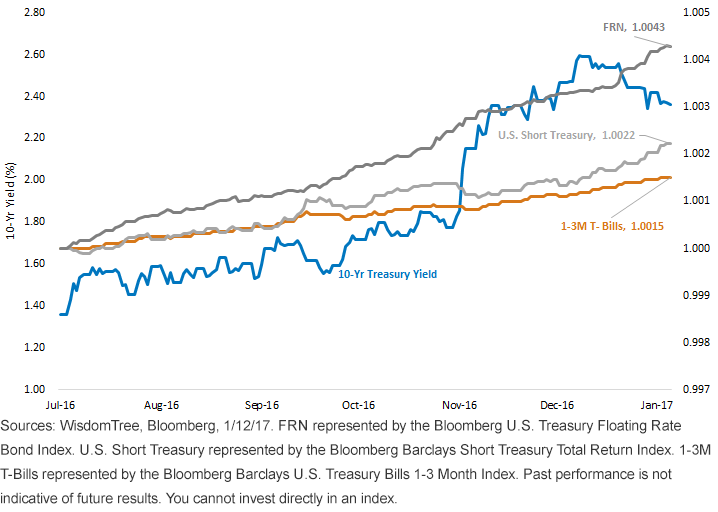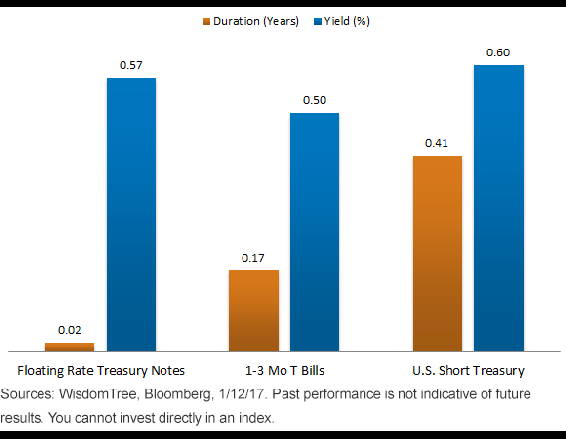Why You Should Take a Look at Floating Rate Treasury Notes


As interest rates rise, bond portfolios will generally lose value. In response, investors have shifted to cash or cash-like positions, such as short-term Treasuries, while they wait to allocate with more conviction. What many do not know is that the Treasury Bills are still very exposed to movements at the short end of the Treasury curve even though they have maturities and durations of less than one year. In many cases, these positions have lost money in rising rate environments, while those consisting of floating rate Treasury notes (FRN) have not. As the 10-year yield looks to be range bound for the coming year, we believe that short-term rates are likely going to rise, given that the Federal Reserve (Fed) is expected to raise rates two to three times in 2017.1
What Are Floating Rate Notes?
While it is a relatively new asset class, floating rate Treasury notes have had some proven success during prior rate hike environments, and investors should look to use them as alternatives to traditional short-term Treasuries. FRNs are 2-year notes that reset weekly to the rate of the newly auctioned 13-week bill. Put simply, these bonds have a one-week duration, because any risk of missed opportunity of investing in higher-yielding bonds is mitigated by the weekly rate reset.
Launched in February 2014, FRNs are the first new marketable security issued by the U.S. Treasury since Treasury Inflation-Protected Securities (TIPS) in 1997. While they may be new, the common risks most new bond issuances face are not as relevant here. First, new bond issuances from untrusted issuers can certainly cause doubt in the minds of investors. However, the U.S. Treasury has been issuing debt for hundreds of years and is arguably the safest lender in the world. Second, investors in bond funds are generally wary of smaller issuances as they can create a constraint on the size of the fund, in addition to potential mispricing due to escalating demand. However, total market value of FRNs is currently above $300 billion and will likely increase given the Treasury’s preference toward issuing additional short-term bonds. Due to the supply constraints of bonds to use in money market funds, the Treasury is increasingly favoring FRNs as a way to meet short-term liability needs.
Why FRNs Could Work Better than Traditional Short-Term Treasuries
One of the biggest reasons we believe investors should consider these securities is because of how they perform in rising rate periods. Compared to various short Treasury or Treasury Bill strategies, FRNs have outperformed during rising rate periods by a sizeable margin. The graph below shows how a few strategies investing in short Treasuries have done as the 10-year rate rose by about 100 basis points (bps). While all the securities in these strategies are considered “safe and liquid” and are issued by the same issuer, as the graph below shows, FRNs have outperformed by about twice as much in the particular period. Where the returns in fixed income generally come from the yield on the bonds, FRNs have an advantage over fixed-rate Treasury Bills because of that same weekly rate reset.
10- Yr Treasury Yield vs. Total Return (7/18/16–1/12/17)

For definitions of indexes in the chart, visit our glossary.
When comparing fixed income options, the first two metrics most investors look at are yield and duration. Short-term fixed income is no different. The chart below compares what each of the three mentioned above has to offer. From a yield perspective, FRNs are comparable to short Treasuries but have beaten them handedly from an interest rate risk or duration standpoint. On both metrics, FRNs beat the 1- to 3-month t-bills, making them the better option, in our view.
Short-Term Fixed Income (1/12/17)

T-Bill Strategies Cannot Adjust Their Yields without Negative Consequences
Another factor to consider is how a strategy can obtain higher rates in its existing framework. If the Fed raises short-term rates, new bonds issued after the hike would be priced with higher yields. But in order for a strategy with 8 to 10 fixed-rate bonds with maturities under one year to take advantage of higher yields, those bonds would have to mature and their proceeds would have to be used to purchase new, higher-yielding bonds. That would take upward of one year. Otherwise, those bonds would have to be sold, likely at a loss, to make room for the new higher-yielding bonds.
In the floating rate bond strategy, every bond in the portfolio has the same weekly reset rate, meaning that as the benchmark and t-bill rates increase, so should the yields on every bond, automatically.
While the Fed cannot directly control the rate of the 10-year or other benchmark rates, it does set what is effectively the world’s short-term benchmark rate. Given that the Fed hiked its rate for the second time in 10 years last month, and is expected to hike over the next two years, we believe it could make sense to allocate to floating rate bonds issued by the U.S. Treasury.
1Source: Bloomberg, 1/17/17.
Important Risks Related to this Article
Securities with floating rates can be less sensitive to interest rate changes than securities with fixed interest rates, but may decline in value. The issuance of floating rate notes by the U.S. Treasury is new and the amount of supply will be limited. Fixed income securities will normally decline in value as interest rates rise.

